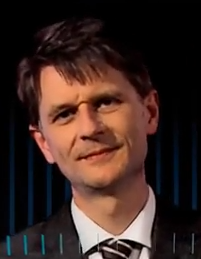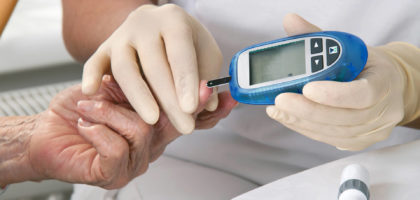Unser Experte für Grippe – Basics
Prof. Dr. med. Hartmut Hengel

Institution und Position: Direktor des Instituts für Virologie des Universitätsklinikums Freiburg. Lehrstuhlinhaber (C4) für Virologie an der Albert-Ludwigs-Universität Freiburg.
Stand: 14.03.2018
Die Mitschrift des Interviews mit Prof. Dr. med. Hartmut Hengel zum Thema “Grippe – Basics”
Virusgrippe und grippaler Infekt – was sind die Unterschiede?
Der Virologe unterscheidet da ganz genau, weil er auf den Erreger schaut. Und die echte Grippe wird durch die Influenza-Viren, die echten Grippeviren, verursacht. Aber es gibt ganz viele andere Viren, die ähnliche Krankheitsbilder hervorrufen können und die führen zum grippalen Infekt. In Wirklichkeit ist jetzt die Unterscheidung an rein klinischen Merkmalen, also wie schwer bin ich erkrankt, wie hoch ist das Fieber, wie lange bin ich erkrankt, wie fühle ich mich, schwer zu treffen. Ganz objektiv kann man die Unterscheidung nur treffen, wenn man den Patienten mit genauen Labormethoden untersucht und das ist die Arbeit des Virologen. Und da der Virologe das macht, unterscheidet er natürlich ganz genau zwischen den echten Grippefällen, die durch das Influenzavirus bedingt sind und den grippalen Infekten, die durch andere Viren bedingt sind. Wie zum Beispiel das Rhinovirus, das kennen sie vielleicht als Schnupfen-Virus oder viele andere Viren, die auch den Respirationstrakt befallen können.
Welche Symptome sprechen für eine „echte Grippe“?
Für die echte Influenza-bedingte Virusgrippe sprechen starke Symptome, dazu gehört ein plötzlicher Beginn, meistens mit relativ hohem Fieber, starkes Krankheitsgefühl, katarrhalische Symptome, also dass man dann zum Beispiel aus der Nase Sekret absondert oder vielleicht sogar schon eine Bronchitis entwickelt, und dann Kopfschmerzen und Gliederschmerzen. Das ist der typische Verlauf einer heftigen Grippe. Aber es gibt eben auch gelegentlich mildere Verläufe, die nicht so typisch erscheinen, die man aber auch ernst nehmen muss.
Wie werden Grippe-Viren übertragen?
Die echten Grippe-Viren, die Influenza-Viren, werden über zwei verschiedene Wege übertragen. Zum einen können sie aus den Respirationstrakt, aus der Lunge ausgeatmet werden und dann als Aerolsol, als kleine Tröpfchen, über gewisse Distanzen von bis zu einigen Metern zum nächsten Patienten kommen. Die andere Möglichkeit ist, dass man Influenza-haltiges Sekret an der Hand hat, zum Beispiel weil man sich an die Nase gefasst hat, weil man mit dem Taschentuch geschnäuzt hat, und diese Hände sind dann natürlich auch Virus-behaftet und so kann man dann auch durch Hautkontakte das Virus übertragen. Auf diese Art und Weise unterscheidet sich das Influenza-Virus im Übertragungsmodus zum Beispiel vom Schnupfen-Virus, vom Rhinovirus, das wird nur durch direkte Kontakte, also kontaminierte Hände, übertragen und geht nicht als Aerosol durch die Luft.
Welche Grippe-Viren sind besonders gefährlich?
Das ist eine interessante Frage für den Virologen und das bedeutet, dass ich etwas ausholen muss und ihnen erklären muss, wie man die Influenzaviren unterscheidet, denn in der Tat gibt es verschiedene Subtypen. Es gibt das Influenza A Virus mit der Version H3N2, ein anderes heißt H1N1 und es gibt Influenza B Viren. Wenn man nun größere Untersuchungen über größere Zeiträume in verschiedenen Ländern macht, dann kann man nachweisen, dass das Influenza H3N2 Virus in den letzten Jahren jedenfalls das war, welches die schwersten Erkrankungen hervorgerufen hat. Im Einzelfall mag das durchaus anders sein, da kann auch das Influenza B Virus schwere Infektionen hervorrufen, aber wenn man das in der gesamten Bevölkerung studiert, dann scheint das H3N2 das gefährlichste.
Wie wird eine Virusgrippe diagnostiziert?
Da muss man etwas unterscheiden zwischen der klinischen Diagnose, die der behandelnde Arzt trifft, der den Verdacht dann auf eine Grippevirus-Infektion äußert und der objektiven Diagnose, die der Virologe im Labor stellt. Um also aus der Verdachtsdiagnose des Arztes, des Hausarztes, des Kinderarztes, des Internisten, eine definitive erregergestützte Diagnose zu machen, braucht es eine Fachuntersuchung im Labor. Das wird in der Regel so durchgeführt, dass ein respiratorisches Material des Patienten untersucht wird, in der Regel ein tiefer Nasenabstrich oder auch ein Trachealsekret, in dem Influenza-Virus enthalten ist. Das wird dann im Labor untersucht und dann objektiv festgestellt, dass dort Influenza-Virus enthalten ist. In der Regel, jedenfalls in unserem Labor, wird dann auch der Subtyp bestimmt, sodass wir genau sagen können, das ist die Viruskonzentration von Influenza A oder B in dem jeweiligen Patienten und haben dadurch auch die Möglichkeit die Virusbelastung des Patienten über die Zeit zu verfolgen und festzustellen, wann der Patient wieder virusfrei ist.
Wie wird die Grippe am besten behandelt?
Also die reine Virusgrippe, die nicht von einer Co-Infektion mit Bakterien begleitet wird, kann in den meisten Fällen symptomatisch behandelt werden. Also etwa dadurch, dass man das Fieber reduziert. Wenn ein schwerer Verlauf vorliegt oder Risikomerkmale beim Patienten, beispielsweise ein Asthma, dann muss man natürlich sehr kritisch darüber denken und auch eine speifische virustatische Therapie mit in Betracht ziehen. Ist es zu einer bakteriellen Co-Infektion gekommen, dann ist eine antibiotische Therapie, die sich gegen die Bakterien richtet, in vielen Fällen erforderlich.
Wann ist die Einnahme von Antibiotika sinnvoll?
Antibiotika sind bei einer reinen Virusgrippe nicht wirksam. Antibiotika wirken nur gegen Bakterien. Insofern ist bei einer reinen Influenza-Infektion ohne Beteiligung von Bakterien eine Antibiotikatherapie nicht erforderlich. Oft kommt es jedoch zu einer Co-Infektion, das heißt das Grippevirus schädigt den Respirationstrakt, die Lunge, was dann dazu führt, dass Bakterien eine Co-Infektion verursachen. In diesen Fällen sollte natürlich eine antibiotische Therapie in Betracht gezogen werden. Allerdings sollte die dann auch gezielt erfolgen und man sollte die Bakterien im Labor auf die Empfindlichkeit des ausgesuchten Antibiotikums dann auch dann testen, so dass man weiß, das Antibiotikum wirkt.
Sollte ich bei einer Grippe das Fieber senken oder besser nicht?
Das Fieber hat seinen Sinn bei der Bekämpfung der Influenza-Infektion, denn bei höheren Temperaturen, also Fieber, vermehrt sich dieses Virus in unserem Respirationstrakt schlechter. Von daher hat das Fieber also einen gewissen Vorteil. Auf der anderen Seite, wenn das Fieber sehr stark anstiegt, wenn das Krankheitsgefühl massiv wird, dann sollte man natürlich doch die Fiebersenkung in Betracht ziehen und entsprechende Medikation beginnen.
Welche Komplikationen können auftreten?
Es gibt häufige Komplikationen bei einer Influenza-Infektion, zum Beispiel die Mittelohrentzündung – die Otitis media – die man dann auch gegebenenfalls antibiotisch behandeln muss und es gibt weitere Komplikationen, die können recht schwerwiegender Natur sein, zum Beispiel eine Herzmuskelentzündung – eine Myokarditis – oder in seltenen Fällen auch eine Entzündungsreaktion gegen das periphere Nervensystem – das GuillainBarré-Syndrom. All das sind schwere Erkrankungen, die im Krankenhaus behandelt werden müssen.
Wann kann ich wieder Sport treiben und arbeiten gehen?
Eine ganz feste Regel gibt es da nicht, dass man sagen würde so und so viele Tage oder Wochen, aber was man allgemein sagen muss ist, die Grippeinfektion kann Komplikationen verursachen, die sich nach der überstandenen Infektion erst zeigen. Zum Beispiel im Bereich des Herz-Kreislauf-Systems oder eine Myokarditis, eine Herzmuskelentzündung. Und von daher sollte man wirklich darauf achten, dass die Grippe komplett ausgeheilt ist und sich erst dann wieder Sport oder auch eine anstrengende Berufstätigkeit zumuten.
Welchen Stellenwert haben homöopathische Therapien?
Bei den homöopathischen Therapien gibt es ein Problem: es gibt keine klinischen Studien, die die Wirksamkeit objektiv nachweisen. Von daher fällt es mir ein bisschen schwer, solche Therapien hier zu empfehlen.
Welchen Schutz bietet die jährliche Grippe-Impfung?
Die Grippe-Impfung wird von der ständigen Impfkommission, der ich auch angehöre, empfohlen für alle Personen ab dem 60. Lebensjahr und für alle chronisch Kranken, die ein erhöhtes Risiko haben durch eine Influenza wirklich zu schwerem Schaden zu kommen. Also es sind zum Beispiel Patienten mit chronischen Stoffwechselstörungen, zum Beispiel Diabetes mellitus, oder Patienten mit chronischer Nierenerkrankung oder Patienten mit chronischer Herz-Kreislauf-Erkrankung oder Patienten mit chronischen Leiden des zentralen Nervensystems, zum Beispiel Multiple Sklerose. Alle diese Patienten sollten sich jährlich eine Grippeschutz-Impfung holen, denn das ist die einzige präventive Möglichkeit, die wir wirklich haben, die gegen die Grippe tatsächlich hilft.
Wie kann ich mich vor einer Infektion am besten schützen?
Zum einen möchte ich noch einmal an die Impfung erinnern, die wir gerade schon kurz angesprochen hatten. Die Impfung, rechtzeitig durchgeführt im Herbst, schützt vor der Infektion im Winter. Darüber hinaus gibt es natürlich andere vorbeugende Maßnahmen, zum Beispiel im Bereich der Händehygiene. Also Händewaschen schützt natürlich vor der Übertragung über Hautkontakt. Oder wenn man in Räumen ist mit anderen möglicherweise Influenza-Kranken, dann hilft es, wenn
Gibt es Risikofaktoren für eine Grippe-Erkrankung?
Ja, die gibt es. Chronische Grunderkrankungen sind Risikofaktoren. Zum Beispiel eine chronische Herz-Kreislauf-Erkrankung, eine chronische Erkrankung der Nieren, also zum Beispiel bei Dialyse-Patienten, eine chronische Lebererkrankung, eine chronische Erkrankung des zentralen Nervensystems, wie die Multiple Sklerose, und natürlich chronische Erkrankungen der Atemwege, der Lunge, wie zum Beispiel Asthma bronchiale. All diese Patienten sollten unbedingt zur Grippeschutzimpfung gehen im Herbst, um auf diese Art und Weise einem schweren Verlauf der Influenza vorzubeugen.
Infos zur Person
Ich bin Virologe an der Universität in Freiburg und Facharzt für medizinische Mikrobiologie, Virologie, und Infektionsepidemiologie und habe von daher schon lange mit Grippeviren und Grippe zu tun. Ich war im Laufe meiner beruflichen Entwicklung unter anderem im Robert-Koch-Institut und dort gibt es ein nationales Referenzzentrum für Influenza, das damals auch in meinen Zuständigkeitsbereich war und wir an unserem Institut in Freiburg diagnostizieren Virusinfektionen und da ist natürlich die Grippe ein wichtiges und häufiges Thema und mein wissenschaftlicher Schwerpunkt, an dem wir auch experimentell arbeiten, sind die Immunologie, die Immunantworten gegen Viren inklusive auch das Influenza-Virus.
Infos zur Klinik
Die Universitätsklinik in Freiburg ist eine große und gutbekannte, traditionelle Universität mit einer großen medizinischen Fakultät und das dortige virologische Institut hat eine lange Geschichte mit bekannten Virologen und ich bin da tätig. Dort wird auch sehr intensiv an Influenzaviren geforscht, von daher sind Influenzaviren etwas mit dem ich jeden Tag befasst bin.
Lebenslauf:
Ausbildung:
| 1980 | Abitur am Theodor-Heuss-Gymnasium Aalen |
| 1980-1981 | Ziviler Ersatzdienst im Rettungsdienst und Krankentransport |
| 1981-1987 | Studium der Humanmedizin an der Universität Ulm |
| 1987 | Ärztliche Prüfung und Approbation als Arzt |
| 1989 | Promotion zum Dr. med. an der Universität Ulm (Prof. Dr. Hermann Wagner, PhD, Institut für Mikrobiologie der Universität Ulm, Abteilung Immunologie) |
Wissenschaftlicher und beruflicher Werdegang:
| 1987-1989 | Institut für Mikrobiologie der Universität Ulm, Abt. Med. Mikrobiologie und Immunologie (Prof. Dr. Hermann Wagner) |
| 1990-1993 | Institut für Mikrobiologie der Universität Ulm, Abt. Virologie (Prof. Dr. Ulrich H. Koszinowski) |
| 1993 | Guest Scientist, Universität Leiden, Niederlande, Department of Immunohematology and Blood Bank (Dr. E. Goulmy) |
| 1993-1996 | Wissenschaftlicher Assistent, Hygiene-Institut der Ruprecht-Karls-Universität Heidelberg, Abt. Virologie (Prof. Dr. Ulrich H. Koszinowski) |
| 1994-1995 | Pädiatrische Weiterbildung, Universitätskinderklinik der Universität Heidelberg (Prof. Dr. Hans Joachim Bremer) |
| 1995-1996 | Weiterbildung in Krankenhaus- und Umwelthygiene, Abt. Hygiene und Med. Mikrobiologie, Hygiene Institut der Universität Heidelberg (Prof. Dr. H.-G. Sonntag) |
| 1996 | Verleihung der Gebietsbezeichnung „Mikrobiologie und Infektionsepidemiologie“, Ärztekammer Nordbaden |
| 1996-1999 | Arbeitsgruppenleiter am Genzentrum der Ludwig-Maximilians-Universität München und am Lehrstuhl Virologie des Max von Pettenkofer-Instituts der Ludwig-Maximilians-Universität München (Prof. Dr. Ulrich H. Koszinowski) |
| 1998 | Habilitation für das Fach Virologie, Venia legendi |
| 2000 | Ernennung zum wiss. Oberassistenten, LMU München |
| 2000-2004 | Leiter des Fachgebietes “Virale Infektionen” am Robert Koch-Institut (RKI) Berlin |
| 2001 | Lehrbefugnis für das Fach Virologie, Fachbereich Humanmedizin, Freie Universität Berlin |
| 2001 | Stv. Leiter der Abteilung Infektionskrankheiten, RKI Berlin |
| 2002 | Vorsitzender des Arbeitskreises „Immunbiologie von Virusinfektionen“ der Gesellschaft für Virologie (GfV) |
| 2002 | Ernennung zum Direktor und Professor am Robert Koch-Institut |
| 2004-2012 | Lehrstuhlinhaber und Direktor des Instituts für Virologie, Heinrich-Heine-Universität Düsseldorf |
| seit 10/2012 | Lehrstuhlinhaber und Direktor des Instituts für Virologie, Albert-Ludwigs-Universität Freiburg |
Mitgliedschaften:
| 2005 – 2009 | Mitglied des Wissenschaftlichen Beirats der Arbeitsgemeinschaft Masern und Varizellen (AGMV) |
| 2007 | Herausgeber Virus Genes (Springer-Verlag) |
| 2007 – 2011 | Herausgeberbeirat Bundesgesundheitsblatt |
| 2007 | Mitglied der Ständigen Impfkommission (STIKO) |
| 2007 | Mitglied Wiss. Beirat des Zentrums für Infektionsbiologie und Immunität (ZIBI) der Humboldt-Universität zu Berlin |
| 2008 – 2011 | Beirat der Gesellschaft für Virologie (GfV) |
| 2008 | Mitglied des Wissenschaftlichen Beirats des IZKF der FAU Erlangen – Nürnberg |
| 2009 – 2012 | Prodekan der Medizinischen Fakultät der Heinrich-Heine-Universität Düsseldorf |
| 2011 | 2. Vizepräsident der Gesellschaft für Virologie (GfV) |
| 2012 | Mitglied im Fachkollegium 204 (Virologie, Mikrobiologie, Immunologie) der Deutschen Forschungsgemeinschaft (DFG)Stv. Vorsitzender des Fachkollegiums 204 der DFGMitglied des Wissenschaftlichen Beirats des Paul-Ehrlich-Instituts, Bundesinstitut für Impfstoffe und biomedizinische Arzneimittel |
Publikationen:
Originalarbeiten (experimentelle Virologie)
-
- Hengel, H., Lindner, M., Wagner, H., und Heeg, K. 1987. Frequency of herpes simplex virus-specific murine cytotoxic T lymphocyte precursors in mitogen- and antigen-driven primary in vitro T cell responses. Journal of Immunology 139: 4196-4202. (IF: 6)
- Hengel, H., Allig, B., Wagner, H., und Heeg, K. 1991. Dissection of signals controlling T cell function and activation: H7, an inhibitor of protein kinase C, blocks induction of primary T cell proliferation by suppressing interleukin (IL)2 receptor expression without affecting IL2 production. European Journal of Immunology 21: 1575-1582. (IF: 4,9)
- Hengel, H., Wagner, H., und Heeg, K. 1991. Triggering of CD8+ cytotoxic T lymphocytes via CD3-e differs from triggering via a/b T cell receptor: CD3-e induced cytotoxicity occurs in the absence of protein kinase C and does not result in exocytosis of serine esterases. Journal of Immunology 147: 1115-1120. (IF: 6)
- Del Val, M., Hengel, H., Häcker, H., Hartlaub, U., Ruppert, T., Lucin, P., und Koszinowski, U.H. 1992. Cytomegalovirus prevents antigen presentation by blocking the transport of peptide-loaded major histocompatibility complex class I molecules into the medial-golgi compartment. Journal of Experimental Medicine 176: 729-738. (IF: 15.2)
- Lucin, P., Jonjic, S., Messerle, M., Polic, B., Hengel, H., und Koszinowski, U.H. 1994. Late phase inhibition of murine cytomegalovirus replication by synergistic action of interferon-gamma and tumor necrosis factor. Journal of General Virology 75: 101-110. (IF: 3.1)
- Hengel, H., Lucin, P., Jonjic, S., Ruppert, T. und Koszinowski, U.H. 1994. Restoration of cytomegalovirus antigen presentation by gamma interferon combats viral escape. Journal of Virology 68: 289-297. (IF: 5.3)
- Boes, B., Hengel, H., Ruppert, T., Multhaupt, G., Koszinowski, U.H., und Kloetzel, P.M. 1994. Interferon g stimulation modulates the proteolytic activity and cleavage site preference of 20S mouse proteasomes. Journal of Experimental Medicine 179: 901-909. (IF: 15.2)
- Steinhoff, U., Zügel, U., Wand-Württemberger, A., Hengel, H., Rösch, R., Munk, M. E., und Kaufmann, S.H.E. 1994. Prevention of autoimmune lysis by T cells with specificity for a heat shock protein by antisense oligonucleotide treatment. Proceedings of the National Academy of Sciences of the United States of America (USA) 91: 5085-5088. (IF: 10,1)
- Zügel, U., Schoel, B., Yamamoto, S., Hengel, H., Morein, B., und Kaufmann, S.H.E. 1995. Crossrecognition by CD8 T cell receptor ab cytotoxic T lymphocytes of peptides in the self and the mycobacterial hsp60 which share intermediate sequence homology. European Journal of Immunology 25: 451-458. (IF: 4,9)
- Hengel, H., Burke, K., Kyburz, D., Zinkernagel, R. M., und Koszinowski U. H. 1995. Peptides control the gain and loss of allele specificity by mutated MHC class I molecules. Journal of Immunology 154: 4557-4564. (IF: 6)
- Thäle, R., Szepan, U., Hengel, H., Geginat, G., Lucin, P., und Koszinowski, U.H. 1995. Identification of the mouse cytomegalovirus genomic region affecting major histocompatibility complex class I molecule transport. Journal of Virology 69: 6098-6105. (IF: 5.3)
- Hengel, H., Eßlinger, C., Pool, J., Goulmy, E., und Koszinowski, U. H. 1995. Cytokines restore MHC class I complex formation and control antigen presentation in human cytomegalovirus-infected cells. Journal of General Virology 76: 2987-2997. (IF: 3.1)
- Polic, B., Jonjic, S., Pavic, I., Crnkovic, I., Zorica, I., Hengel, H., Lucin, P., und Koszinowski, U.H. 1996. Lack of MHC class I complex expression has no effect on spread and control of cytomegalovirus infection in vivo. Journal of General Virology 77: 217-225. (IF: 3.1)
- Hengel, H., Flohr, T., Hämmerling, G.J., Koszinowski, U.H. und F. Momburg. 1996. Human cytomegalovirus inhibits peptide translocation into the endoplasmic reticulum for MHC class I assembly. Journal of General Virology 77: 2287-2296. (IF: 3.1)
- Ziegler, H., Thäle, R., Lucin, P., Muranyi, W., H., Flohr, T., Hengel, H., Farell, H., Rawlinson, W., und Koszinowski, U.H. 1997. A mouse cytomegalovirus glycoprotein retains MHC class I complexes in the ERGIC/cis-Golgi compartments. Immunity 6: 57-66. (IF: 20,6)
- Geginat, G., Ruppert, T., Hengel, H., Holtappels, R., und Koszinowski, U.H. 1997. IFN-g is a prerequisite for optimal antigen processing of viral peptides in vivo. Journal of Immunology 158: 3303-3310. (IF:6)
- Hengel, H., Koopmann, J.O., Flohr, T., Muranyi, W., Goulmy, E., Hämmerling, G.J., Koszinowski, U.H. und Momburg, F. 1997. A viral ER resident glycoprotein inactivates the MHC encoded peptide transporter. Immunity 6: 623-632. (IF: 20,6)
- Polic, B., Hengel, H., Krmpotic, A., Trgovcich, J., Pavic, I., Lucin, P., Jonjic, S. und Koszinowski, U.H. 1998. Hierarchical and redundant lymphocyte subset control precludes cytomegalovirus replication during latent infection. Journal of Experimental Medicine 188: 1047-1054. (IF: 15.2)
- Reusch, U., Muranyi, W., Lucin, P., Burgert, H.-G., Hengel, H., und Koszinowski, U.H. 1999. A cytomegaloviral glycoprotein reroutes MHC class I complexes into lysosomes for degradation. EMBO Journal 18: 1081-1091. (IF: 8,3)
- Ulbrecht M., Martinozzi, S., Grzeschik, M., Hengel, H., Ellwart, J.M., Pla, M., und Weiss, E.H. 2000. Cutting edge: The human cytomegalovirus UL40 gene product contains a ligand for HLA-E and prevents natural killer cell mediated lysis. Journal of Immunology, 164: 5019-5022. (IF: 6)
- Benz, C. und Hengel, H. 2000. MHC class I-subversive gene functions of cytomegalovirus and their regulation by interferons – an intricate balance. Virus Genes 21: 39-47. (IF: 1,4)
- Hengel, H., Reusch, U., Geginat, G., Holtappels, R., Ruppert, T., Hellebrand, E. und Koszinowski, U.H. 2000. Macrophages escape inhibition of major histocompatibility complex class I dependent antigen presentation by cytomegalovirus. Journal of Virology 74: 7861-7868. (IF: 5.3)
- Benz, C., Reusch, U., Muranyi, W., Brune, W. Atalay, R. und Hengel, H. 2001. Efficient downregulation of major histocompatibility complex class I molecules in human epithelial cells infected with cytomegalovirus. Journal of General Virology, 82: 2061-2070. (IF: 3.1)
- Krmpotic, A., Busch, D.H., Bubic, I., Gerhard, F., Hengel, H., Hasan, M., Scalzo, A.A., Koszinowski U.H., und Jonjic, S. 2002. Dual function of an MCMV immunoevasion gene: m152/gp40 glycoprotein confers virus resistance to CD8+ T lymphocytes and NK cells in vivo. Nature Immunology, 3: 529-535. (IF: 25,1)
- Atalay, R., Zimmermann, A., Wagner, M., Borst, E., Benz, C., Messerle, M., Hengel, H. 2002. Identification and expression of human cytomegalovirus transcription units coding for two distinct Fc-receptor homologs. Journal of Virology, 76: 8596-8608. (IF: 5.3)
- Ulbrecht, M., Hofmeister, V., Yüksekdag, G., Ellwart, J.W., Hengel, H., Momburg, M., Martinozzi, S., Reboul, M., Pla, M., und Weiss, E.H. 2003. HCMV glycoprotein US6 mediated inhibition of TAP does not affect of HLA-E dependent protection of K-562 cells from NK cell lysis. Human Immunology 64: 231-237. (IF: 3,1)
- Karrer, U., Sierro, S., Wagner, M., Oxenius, A., Hengel, H., Koszinowski, U.H., Klenerman, P., und Phillips, R. E. 2003. Memory Inflation: Continous accumulation of antiviral CD8+ T cells over time. Journal of Immunology, 170: 2022-2029. Correction (2003): Journal of Immunology, 171: 3895 (IF: 6)
- Khan, S., Zimmermann, A., Basler, M., Groettrup, M., und Hengel, H. 2004. Modulation of immunoproteasomes subcomposition by cytomegalovirus: A cytomegaloviral inhibitor of IFN- signaling controls immunoproteasome induction. Journal of Virology, 78: 1831 – 1842. (IF: 5.3)
- Karrer, U., Wagner, M., Sierro, S., Oxenius, A., Hengel, H., Dumrese, T., Freigang, S., Koszinowski, U.H., Phillips, R. E. und Klenerman P. 2004. Expansion of protective CD8+ T cell responses driven by recombinant cytomegaloviruses. Journal of Virology, 78: 2255 – 2264. (IF: 5.3)
- Seifert, U., Liermann, H., Racanelli, V., Halenius, A., Wiese, M., Wedemeyer, H., Ruppert, T., Rispeter, K., Henklein, P., Sijts, A., Hengel, H., Kloetzel, P-M., and Rehermann, B. 2004. Hepatitis C virus mutation affects proteasomal epitope processing in vitro and in vivo. Journal of Clinical Investigation, 114: 250 – 259. (IF: 16.6)
- Hasan, M., Krmpotic, A., Ruzsics, Z., Bubic, I., Lenac, T., Halenius, A., Loewendorf, A., Messerle, M., Hengel, H., Jonjic, S., and Koszinowski, U.H. 2005. Selective down-regulation of NKG2D ligand H60 by mouse cytomegalovirus m155 glycoprotein. Journal of Virology, 79:2920-2930. (IF: 5.3)
- Krmpotic, A., Hasan, M., Loewendorf, A., Saulig, T., Halenius, A., Lenac, T., Polic, B., Bubic, I., Kriegeskort, A., Messerle, M., Hengel, H., Busch, D. Koszinowski, U.H. and Jonjic, S. 2005. NK cell activation through the NKG2D ligand MULT-1 is selectively prevented by the glycoprotein encoded by mouse cytomegalovirus (MCMV) gene m145. Journal of Experimental Medicine, 201:211-220. (IF: 15.2)
- Zimmermann, A., Trilling, M., Wagner, M., Bubic, I., Wilborn, M., Jonjic, S., Koszinowski, U., und Hengel, H. 2005. A viral protein reveals a dual role for STAT2 in IFN- signaling and antiviral responses. Journal of Experimental Medicine, 201:1543-1553. (IF: 15.2)
- Valés–Gómez, M., Winterhalter, A., Roda-Navarro-P., Zimmermann, A., Boyle L., Hengel, H., Brooks, A., und Reyburn H. T. 2006. The human cytomegalovirus glycoprotein UL16 traffics through the plasma membrane and the nuclear envelope. Cellular Microbiology, 8:581-590. (IF: 5.6)
- Halenius, A., Momburg, F., Reinhard, H., Bauer, D., Lobigs, M., und Hengel, H. 2006. Physical and functional interactions of the cytomegaloviurs US6 glycoprotein with the transporter associated with antigen processing (TAP). Journal of Biological Chemistry, 281:5383-5390. (IF: 5.5)
- Gumá, M., Budt, M., Sáez, A., Brckalo, T., Hengel, H., Angulo, A., und López-Botet, M. 2006. Expansion of CD94/NKG2C+ NK cells in response to human cytomegalovirus-infected fibroblasts. Blood, 107:3624-3631. (IF: 10.4)
- Lenac, T., Budt, M., Arapovic, J., Hasan, M., Zimmermann, A., Simic, H., Krmpotic, A., Messerle, M., Ruzsics, Z., Koszinowski, U.H., Hengel, H.*, and Jonjic, S*. 2006. The herpesviral Fc receptor fcr-1 as a potent down-regulator of the NKG2D ligands MULT-1 and H60. Journal of Experimental Medicine, 203:1843-2850. (IF: 15.2) *Corresponding authors
- Masihi, K.N., Schweiger, B., Finsterbusch, T., Suplie, A., und Hengel, H. 2007. Low dose oral combinatory chemoprophylaxis with oseltamivir and amantadine for influenza A virus infections in mice. Journal of Chemotherapy, 19:295-303. (IF: 0,8)
- Stern-Ginossar, N., Elefant, N., Zimmermann, A., Wolf, D.G., Saleh, N., Biton, M., Horwitz, E., Prokocimer, Z., Prichard, M., Goldman-Wohl, D., Greenfield, C., Yagel, S., Hengel, H., Altuvia, Y., Margalit, H., Mandelboim, O. 2007. Host immune system gene targeting by a viral miRNA. Science, 317:376-381. (IF: 28.1)
- Sinzger, C., Hahn, G., Digel, M., Katona, R., Sampaio, K.L., Messerle, M., Hengel, H., Koszinowski, U., Brune, W., Adler, B. 2008. Cloning and sequencing of a highly productive, endotheliotropic virus strain derived from human cytomegalovirus TB40/E. Journal of General Virology, 89:359-368. (IF: 3.1)
- Sprague, E. R., Reinhard, H., Cheung, E.J., Farley, A. H., Trujillo, R. D., Hengel, H., and Bjorkman, P.J. 2008. The human cytomegalovirus Fc receptor gp68 binds the Fc CH2-CH3 interface of IgG. Journal of Virology, 82:3490 – 3499. (IF: 5. 3)
- Le, V. T. K., Trilling, M., Zimmermann, A., Hengel, H. 2008. Mouse cytomegalovirus inhibits interferon- gene expression and controls activation pathways of the interferon- enhanceosome. Journal of General Virology, 89:1131 – 1141. (IF: 3.1)
- Walton, S.M., Wyrsch, P., Munks, M.W., Zimmermann, A., Hengel, H., Hill, A.B., and Oxenius, A. 2008. The dynamics of MCMV specific CD4 T cell responses during acute and latent infection. Journal of Immunology, 181:1128 – 1134. (IF: 6)
- Le, V. T. K., Trilling, M., Wilborn, M., Hengel, H., and Zimmermann, A. 2008. Human cytomegalovirus interferes with signal transducer and activator of transcription (STAT) 2 protein stability and tyrosine phosphorylation. Journal of General Virology, 89:2416 – 2426. (IF: 3.1)
- Menotti, L., Cerretani, A., Hengel, H., and Campadelli-Fiume, G. 2008. Construction of a fully retargeted herpes simplex virus 1 capable to enter cells solely via the human epidermal growth factor receptor 2 (HER2). Journal of Virology, 82:10153 – 10161. (IF: 5.3)
- Brenndörfer, E. D., Karthe, J., Frelin, L., Cebula, P. Erhardt, A., Schulte am Esch, J., Hengel, H., Bartenschlager, R., Sällberg, M., Häussinger, D., and Bode, J.G. 2009. The non-structural 3/4A protease of HCV activates EGF-induced signal-transduction by cleavage of the T-cell protein tyrosine phosphatase. Hepatology, 49:1810 – 1820. (IF: 11.4)
- Trilling, M., Le, V.T.K., Zimmermann, A., Ludwig, H., Pfeffer, K., Sutter, G., Smith, G.L., and Hengel, H. 2009. An IFN- induced IRF-1-dependent antiviral response inhibits vaccinia virus replication in mouse but not human fibroblasts. Journal of Virology, 83:3684 – 3695. (IF: 5.3)
- Deckers, M., Hofmann, J., Kreuzer, K.A., Reinhard, H., Edubio, A., Hengel, H., Voigt, S., and Ehlers B. 2009. High genotypic diversity and a novel variant of human cytomegalovirus revealed by combined UL33 / UL56 genotyping with broad-range PCR. Virology J, 6:210. (IF: 2.55)
- Magri, G., Muntasell, A., Romo, N., Sáez-Borderias, A., Pende, D., Geraghty, D.E., Hengel, H., Angulo, A., Moretta, A., López-Botet, M. 2011. NKp46 and DNAM-1 NK cell receptors drive the response to human cytomegalovirus infected myeloid dendritic cells overcoming viral immune evasion strategies. Blood, 117:848 – 856. (IF: 10.4)
- Reinhard, H, Le, V.T.K., Ohlin, M., Hengel, H*. Trilling, M*. 2011. Exploitation of herpesviral transactivation allows quantitative reporter gene-based assessment of virus entry and neutralization in adherent and non-adherent cells. PLoS ONE, Jan 17;6(1):e14532. (IF: 4.35) *corresponding author
- Verweij, M.C., Knetsch, W., Quinten, E-. Halenius, A., van Bel, N., Drijfhout, J.W., Ressing, M.E., Hengel, H., van Hall, T., Wiertz, E. 2010. Inhibition of mouse TAP by immune evasion molecules encoded by non-murine herpesviruses. Molecular Immunology, 48:835 – 845. (IF: 3.6).
- Halenius, A., Hauka, S., Dölken, L., Stindt, J., Reinhardt, H., Wiek, C., Hanenberg, H., Koszinowski, U.H., Momburg, F., and Hengel, H. 2011. Human cytomegalovirus disrupts the MHC class I peptide loading complex (PLC) and inhibits tapasin gene transcription” Journal of Virology, 85:3473 – 3485. (IF: 5.3).
- Pfannkuche, A., Büther, K., Karthe, J., Poenisch, M., Bartenschlager, R., Trilling, M., Hengel, H., Willbold, D., Häussinger, D., and Bode, J.G. 2011. c-Src is required for complex formation between the hepatitis C virus encoded proteins NS5A and NS5B – a prerequisite for replication. Hepatology, 53:1127 – 1136. (IF: 11.4).
- Scuda, N., Hofmann, J., Calvignac, S., Ruprecht, K., Liman, P., Kühn, J., Hengel., H. and Ehlers, B. 2011. A novel human polyomavirus closely related to the African green monkey-derived lymphotropic polyomavirus (LPV). Journal of Virology, 85:4586 – 4590. (IF: 5.3).
- Trilling, M., Le, V.T.K., Fiedler, M., Bleifuß, E., Zimmermann, A., and Hengel, H. 2011. Cytomegaloviral interferon signalling antagonist pM27 recruits DDB1-Ubiquitin-Ligase-complexes to target STAT2 for proteasomal degradation. PLoS Pathogens, Jun;7(6):e1002069 (IF: 9,1).
- Jarahian, M., Fiedler, M., Cohnen, A., Djandji, D., Hämmerling, G.J., Gati, C., Cerwenka, A., Turner, P.C., Moyer, R.W., Watzl, C., Hengel, H. and Momburg, F. 2011. Modulation of NKp30- and NKp46-Mediated Natural Killer Cell Responses by Poxviral Hemagglutinin. PLoS Pathogens, Aug;7(8):e1002195 (IF: 9,1).
- Walton, S.M., Mandaric, S., Torti, N., Zimmermann, A., Hengel, H. and Oxenius, A. 2011. Absence of cross-presenting cells in the salivary gland and viral immune evasion confine cytomegalovirus immune control to effector CD4 T cells. PLoS Pathogens, Aug;7(8):e1002214 (IF: 9,1).
- Le, V.T.K., Trilling H. and Hengel, H. 2011. The cytomegaloviral protein pUL138 acts as potentiator of TNF receptor 1 surface density to enhance ULb’-encoded modulation of TNF- signaling. Journal of Virology, 85: 13260 – 13270. (IF: 5.3).
- Honke, N., Shaabani, N., Cadeddu, G., Sorg, U.R., Zhang, D.R., Trilling M., Klingel, K., Sauter, M., Kandolf, R., Gailus, N., van Rooijen, N., Burkart, C., Baldus, S.E., Grusdat, M., Löhning, M., Hengel, H., Pfeffer, K., Tanaka, M., Häussinger, D., Recher, M., Lang, P.A., Lang, K.S. 2012. Enforced virus replication” activates adaptive immunity and is essential to control cytopathic virus. Nature Immunology, 13: 51-57. (IF: 25.1).
- Shikhagaie, M., Mercé-Maldonado, E., Isern, E., Muntasell, A., Mar Albà, M., López-Botet, M., Hengel, H. and Angulo, A. 2012. The HCMV-specific UL1 gene encodes a late phase glycoprotein incorporated in the virion envelope. Journal of Virology, 86: 4091 – 4101. (IF: 5.3).
- Stern-Ginossar, N., Weisburd, B., Michalski, A., Le, V.T.K., Hein, M.Y, Huang, S.X., Ma, M., Shen, B., Qian, S.B., Hengel, H., Mann, M., Ingolia, N.T., and Weissman, J.S. 2012. Decoding human cytomegalovirus. Science, 338: 1088 – 1093. (IF: 28.1)
- Corrales-Aguilar, E., Trilling, M., Reinhard, H., Mercé_Maldonado E., Widera, M., Schaal, H., Zimmermann, A., Mandelboim, O. and Hengel, H. 2012. A novel assay for detecting virus-specific antibodies triggering activation of Fc receptors. Journal of Immunological Methods, 387: 21 – 35. (IF: 2,3)
- Krawczyk, A., Arndt, M.A.E., Grosse-Hovest, L., Weichert, W., Giebel, B., Dittmer, U., Hengel, H., Jäger, D., Schneweis, K.E., Eis-Hübinger, A.M., Roggendorf, M., and Krauss, J. 2013. Overcoming drug resistant Herpes Simplex Virus (HSV) infection by a novel humanized antibody. Proceedings of the National Academy of Sciences of the United States of America (USA) 110: 6760 – 65. (IF: 10,1)
- Beutler, N., Hauka, S., Niepel, A., Kowalewski, D.J., Uhlmann, J., Ghanem, E., Erkelenz, S., Wiek, C., Hanenberg, H., Schaal, H., Stevanovic, S., Spinger, S., Momburg, F., Hengel, H., and Halenius, A. 2013. A natural tapasin isoform lacking exon 3 modifies peptide loading complex function. European Journal of Immunology 43: 1459 – 69. (IF: 4,9)
Klinische und infektionsepidemiologische Originalarbeiten
-
- Grau, A.J., Buggle, F., Becher, H., Zimmermann, E., Spiel, M., Fent, T., Maiwald, M., Werle, E., Zorn, M., Hengel, H. und Hacke, W. 1998. Recent bacterial and viral infection is a risk factor for cerebrovascular ischemia. Clinical and biochemical studies. Neurology 50: 196-203. (IF: 7)
- Enders, G., Dotsch, J., Bauer, J., Nützenadel, W., Hengel, H., Haffner, D., Schalasta, G., Searle, K., und Brown, K.E. 1998. Life-threatening parvovirus B19- associated myocarditis and cardiac transplantation as a possible therapy: two case reports. Clinical Infectious Diseases, 26: 355-358. (IF: 8.3)
- Burger, M., Schnitzler, P., Böhler, T., und Hengel, H. 1998. Swabs: an excellent source for the detection of varicella-zoster virus and herpes simplex virus skin infections by polymerase chain reaction (PCR). Pädiatr. Grenzgeb., 37: 165-180. (IF: nicht verfügbar)
- Weber, C., von Stülpnagel, C., Weber K.S.C., Hengel, H., und Weber P.C. 2001. Association of myocardial infarction with mononuclear cell expression of the cytomegalovirus chemokine receptor US28 in patients with NIDDM. Experimental and Clinical Cardiology, 6: 105-108. (IF: nicht verfügbar)
- Santibanez, S., Tischer A., Heider A., Siedler, A., und Hengel, H. 2002. Rapid replacement of endemic measles virus genotypes. Journal of General Virology, 83: 2699-2708. (IF: 3.1)
- Tischer, A., Santibanez, S., Siedler, A., Heider, A., and Hengel, H. 2004. Laboratory investigations are indispensable to monitor the progress of measles elimination – Results of the German Measles Sentinel 1999 – 2003. Journal of Clinical Virology, 31:165 – 178. (IF: 3.3)
- Santibanez, S., Niewiesk, S., Heider, A., Schneider-Schaulies, J., Berbers, G. A. M., Zimmermann, A., Halenius, A., Wolbert, A., Deitemeier, I., Tischer, A., and Hengel, H. 2005. Probing neutralizing antibody responses against emerging measles viruses (MVs): immune selection of MV by H protein-specific antibodies? Journal of General Virology, 86:365 – 374. (IF: 3.1)
- Ludwig, A., and Hengel, H. 2009. Epidemiological impact and disease burden of congenital cytomegalovirus infection in Europe. Euro Surveill. 14:26 – 32. (IF: 6,15)
- Winzer, R., Kanig, N., Schneitler, S., Reuter, S., Jensen, B., Müller-Stöver, I., Oh, J., Adams, O., Mayatepek, E., Hengel, H., Schneitler, H., and Häussinger, D. 2009. Erste klinische Erfahrungen mit der Neuen Influenza A (H1N1/09). Deutsches Ärzteblatt 106:770-776.
- Warnke, C., Smolianow, C., Dehmel T., Andrée, M., Hengel, H., Zooren, F., Arendt, G., Wiendl, H., Haas, R., Hartung, H.P., Adams, O., Kieseier B.C. 2011. CD34+ progenitor cells mobilized by natalizumab are not a relevant reservoir for JC virus. Multiple Sclerosis, 17:151 – 6. (IF: 4,2)
- Hansen, A., Grund, S., Hetzel, G., Ivens, K., Sümmchen, H.A., Zgoura, P., Hengel, H., Adams, O., and Rump, L.C. 2012. Noncontrolled Trial of Monovalent AS03A-Adjuvanted Vaccine for 2009 Pandemic Influenza A(H1N1) in Long-term Dialysis Patients and Transplant Recipients. American Journal of Kidney Diseases, 59:471 – 3. (IF: 5,2)
- Mentzer, D., Prestel, J., Adams, O., Gold, R., Hartung, H.-P., Hengel, H., Kieseier, B.C., Ludwig, W.-D., Keller-Stanislawski, B. 2012. Case definition for progressive multifocal leukoencephalopathy following treatment with monoclonal antibodies. Journal of Neurology, Neurosurgery & Psychiatry, 83: 927 – 933. (IF: 4,8)
- Adams, O., Werzmirzowsky, J., and Hengel H. 2013. Genetic analysis and antigenic characterization of human respiratory syncytial virus group A viruses isolated in Germany 1996 – 2008. Virus Genes, x y (IF: 1,7)
- Siedler, A., Hecht, J., Rieck, T., Tolksdorf, K., and Hengel, H. 2013. Varicella Vaccination in Germany – a provisional appraisal in the context of MMR vaccination. Bundesgesundheitsblatt Gesundheitsforschung Gesundheitsschutz, 57: x-y (IF: 0,7)
Übersichtsarbeiten
-
- Lucin, P., Jonjic, S., Hengel, H., Pavic, I., Polic, B., Crnkovic, I., Thäle, R., Zorica I., und Koszinowski, U.H. 1994. Cytomegalovirus persistence in salivary glands by evasion from immunological control. Regional Immunolgy, 6: 391-397.
- Hengel, H., und Koszinowski, U.H. 1997. Interference with antigen processing by viruses. Current Opinion in Immunology, 9: 470-476. (IF: 10.5)
- Hengel, H., Brune W., und Koszinowski, U.H. 1998. Immune evasion by cytomegalovirus – survival strategies of a highly adapted opportunist. Trends in Microbiology, 6:190-197. (IF: 6.1)
- Hengel, H., Brune, W., und Koszinowski, U.H. 1998. Viral Genes involved in immune evasion of cytomegalovirus. Nova acta Leopoldina, NF 78, Nr. 307, 1-15.
- Hengel, H., Reusch, U., Gutermann, A., Ziegler, H., Jonjic, S., Lucin, P., und Koszinowski U.H. 1999. Cytomegaloviral control of MHC class I function in the mouse. Immunological Reviews 168, 167-176. (IF: 11.8)
- Brune, W., Hengel, H., und Koszinowski, U.H. 1999. A mouse model for cytomegalovirus infection. In: Current Protocols in Immunology, John Wiley & Sons, New York 19.7.1-19.7.13.
- Hengel, H. und Weber, C. 2000. Driving cells into the atherosclerotic plaque – a deleterious role for viral chemokine receptors? Trends in Microbiology, 8: 294-296. (IF: 6.1)
- Momburg, F. und Hengel, H. 2002. Corking the bottleneck: the transporter associated with antigen processing (TAP) as a target for immune subversion by viruses. Current Topics in Microbiology and Immunology 269: 57-74. (IF: 5.1)
- Masihi, K.N. und Hengel, H. 2003. Combinatorial immunotherapies for infectious diseases. International Immunopharmacology 3: 1159-1167. (IF: 2.2)
- Zimmermann, A., Trilling M., Wilborn, M., und Hengel, H. 2003. Counteraction of interferon induced antiviral responses by cytomegalovirus. Monographs in Virology, 24: 71–82.
- Budt, M., Reinhard, H., Bigl, A., und Hengel, H. 2004. Herpesviral Fcg receptors: culprits attenuating antiviral IgG? International Immunopharmacology, 4: 1135-1148. (IF: 2.2)
- Hengel, H., Koszinowski, U.H., und Conzelmann, K.K. 2005. Viruses know it all: new insights into interferon networks. Trends in Immunology, 26:396 – 401. (IF: 9.9)
- Hengel, H. und Koszinowski, U.H. 2010. A vaccine monkey wrench? Science 328: 51-52. (IF: 28.1)
- Loebermann, M., Winkelmann, A., Hartung, H.-P., Hengel, H., Reisinger, E.C., und Zettl, U.K. 2012. Vaccination against infection in patients with multiple sclerosis. Nature Reviews Neurology, 8: 143 – 151. (IF: 6,5)
- Trilling, M., Le, V.T.K., and Hengel, H. 2012. Interplay between cytomegaloviruses and interferon signalling: implications for pathogenesis and therapeutic intervention. 2012. Future Microbiology 7: 1269-1282 (IF: 3,8)
- Grund, S., Wichmann, O., Mertens, T., und Hengel, H. 2013. Konzepte, Wirksamkeit und Perspektiven pandemischer und nicht-pandemischer Influenzaimpfungen. Bundesgesundheitsblatt Gesundheitsforschung Gesundheitsschutz, 56: 76-86 (IF: 0,7)
- Koch, J., Wiese-Posselt, M., Remschmidt, C., Wichmann, O., Bertelsmann, H., Garbe, E., Hengel, H., Meerpohl, JJ., Mas Marques, A., Oppermann, H., Hummers-Pradier, E., von Kries, R., und Mertens, T. 2013. Background paper to the recommendation for routine rotavirus vaccination of infants in Germany. Bundesgesundheitsblatt Gesundheitsforschung Gesundheitsschutz, 56: 957 – 984 (IF: 0,7)
Publikationen ohne peer review, Buchbeiträge, Lehrbücher, Editorials
-
- Hengel, H. Detection of Varizella-Zoster Virus Infection by Polymerase Chain reaction. In: “PCR: Protocol for diagnosis of human and animal virus diseases“. Eds.: Y. Becker and G. Darai. Springer Verlag, Heidelberg, 1995, Seiten 195-203.
- Hengel, H. Allgemeine Virologie. In: „Mikrobiologie und Immunologie“. Kurzlehrbuch zum Gegenstandskatalog. Hrsg. M. Oethinger. 9. Auflage 1997. Gustav Fischer Verlag, Stuttgart, Seite 158-172.
- Hengel, H. Spezielle Virologie. In: „Mikrobiologie und Immunologie“. Kurzlehrbuch zum Gegenstandskatalog. Hrsg. M. Oethinger. 9. Auflage 1997. Gustav Fischer Verlag, Stuttgart, Seite 173-216.
- Hengel, H. Cytomegalie Virus. In: „Lexikon der Infektionskrankheiten des Menschen. Erreger, Symptome, Therapie und Prophylaxe“. Hrsg. G. Darai, M. Handermann, E. Hinz und H.-G. Sonntag. 1. Auflage 1997. Springer Verlag Heidelberg, Seite 132-136.
- Hengel, H. Varizella-Zoster Virus. In: „Lexikon der Infektionskrankheiten des Menschen. Erreger, Symptome, Therapie und Prophylaxe“. Hrsg. G. Darai, M. Handermann, E. Hinz und H.-G. Sonntag. 1. Auflage 1997. Springer Verlag Heidelberg, Seite 557-560.
- Hengel, H. Masern Virus. In: „Lexikon der Infektionskrankheiten des Menschen. Erreger, Symptome, Therapie und Prophylaxe“. Hrsg. G. Darai, M. Handermann, E. Hinz und H.-G. Sonntag. 1. Auflage 1997. Springer Verlag Heidelberg, Seite 311-316.
- Hengel, H., und Koszinowski, U.H. Inhibition of MHC class I function by cytomegalovirus. In: „Herpesviruses and Immunity“. Eds. M. Bendinelli, H. Friedman und P. Medveczky. Plenum Press, New York, London, Moscow, 1998, Seite 247-264.
- Hengel, H. Allgemeine Virologie. In: „Mikrobiologie und Immunologie“. Kurzlehrbuch zum Gegenstandskatalog. Hrsg. M. Oethinger. 10. Auflage 2000. Urban und Fischer Verlag, München, S. 158-172.
- Hengel, H. Spezielle Virologie. In: „Mikrobiologie und Immunologie“. Kurzlehrbuch zum Gegenstandskatalog. Hrsg. M. Oethinger. 10. Auflage 2000. Urban und Fischer Verlag, München, S. 173-216.
- Einsele, H., Heesemann, J., Roggenkamp, A., Hengel, H., und Koszinowski, U. 2000. Infektionen bei Immunsuppression. In: „Klinische Infektiologie“ Hrsg.: R. Marre, T. Mertens, M. Trautmann, E.Vanek. Urban & Fischer, München, S. 793-810.
- Leitritz, L., Roggenkamp, A., Sing, A., Schubert, S., Hauser, U., Wilske, B., Eberle, J., Haas, J., Hengel, H., Autenrieth, I., Koszinowski, U. und Heesemann, J. 2000. Kapitel 3: Bakteriologie, Mykologie, Parasitologie, und Virologie. In: Müller/Seifert „Taschenbuch der medizinisch-klinischen Diagnostik“ Hrsg.: S.C. Scriba, A. Pforte. 73. Auflage, Springer Verlag Heidelberg, S. 116-153.
- Bauer, D., Momburg, F., und Hengel, H. 2000. Manipulation of MHC-encoded proteins by cytomegaloviruses. In: “Major Histocompatibility complex. Evolution, Structure, and Function.” M. Kasahara, Ed. Springer Verlag Tokyo Heidelberg New York, Seite 305-319.
- Hengel, H., und Koszinowski, U.H. 2002. Muromegalovirus. In: “The Springer Index of Viruses”. Hrsg. C.A. Tidona und G. Darai. Springer Verlag, Heidelberg, S. 423-427.
- Zimmermann, A., Halenius, A., und Hengel, H. 2002. Cytomegalovirus glycoproteins interacting with MHC class I molecules and the MHC-encoded peptide transporter. In: „Structure-Function Relationship of Human Pathogenic Viruses“. E. Bogner, A. Hozenburg, Eds., Plenum-Kluwer Press, New York, 465-484.
- Hengel, H. Cytomegalie Virus. In: „Lexikon der Infektionskrankheiten des Menschen. Erreger, Symptome, Therapie und Prophylaxe“. Hrsg. G. Darai, M. Handermann, E. Hinz und H.-G. Sonntag. 2. Auflage 2003. Springer Verlag Heidelberg, S. 167-171.
- Hengel, H. Varizella-Zoster Virus. In: „Lexikon der Infektionskrankheiten des Menschen. Erreger, Symptome, Therapie und Prophylaxe“. Hrsg. G. Darai, M. Handermann, E. Hinz und H.-G. Sonntag. 2. Auflage 2003. Springer Verlag Heidelberg, S. 727-731.
- Hengel, H. Masern Virus. In: „Lexikon der Infektionskrankheiten des Menschen. Erreger, Symptome, Therapie und Prophylaxe“. Hrsg. G. Darai, M. Handermann, E. Hinz und H.-G. Sonntag. 2. Auflage 2003. Springer Verlag Heidelberg, S. 403-408.
- Hengel, H. Herpesviren. In: „Infektionskrankheiten“. Hrsg. N. Suttorp, M. Mielke, W. Kiehl, B. Stück. 2003. Georg Thieme Verlag, Stuttgart, S. 572-574.
- Kohl, P. K., Jodl, S.J., und Hengel, H. Herpes-simplex-Virus Typ1 und Herpes-simplex-Virus Typ2/HSV-Infektion. In: „Infektionskrankheiten“. Hrsg. N. Suttorp, M. Mielke, W. Kiehl, B. Stück. 2003. Georg Thieme Verlag, Stuttgart, S. 325-326.
- Hengel, H. Allgemeine Virologie. In: „Mikrobiologie und Immunologie“. Kurzlehrbuch zum Gegenstandskatalog. Hrsg. M. Oethinger. 11. Auflage 2004. Urban und Fischer Verlag, München, S. 155-171.
- Hengel, H. Spezielle Virologie. In: „Mikrobiologie und Immunologie“. Kurzlehrbuch zum Gegenstandskatalog. Hrsg. M. Oethinger. 11. Auflage 2004. Urban und Fischer Verlag, München, S. 172-215.
- Zimmermann, A., und Hengel, H. 2005. Cytomegalovirus interference with Interferons. In: Cytomegalovirus: Molecular Biology and Immunology. Ed: M.J. Reddehase. Caister Academic Press, ISBN 1-904455-02-6. S. 321 – 339.
- Ludwig, A., Hengel, H. 2006. Epidemiologie und klinische Bedeutung der angeborenen Zytomegalievirusinfektion. PÄD Praktische Pädiatrie, 12, S.226-235.
- Adams, O., Hengel, H. 2006. Husten, Schnupfen, Heiserkeit – über alte und neue Respirationstraktviren. In: Jahrbuch der Heinrich-Heine-Universität Düsseldorf 2005/2006. Seite 85-101.
- Ludwig, A., Hengel, H. 2007. Epidemiologie und klinische Bedeutung der angeborenen Zytomegalievirusinfektion. GYN Praktische Gynäkologie, 12, S.215-221. (Inhaltlich identisch mit No. 23).
- Hengel, H. 2007. Prävention und Aufklärung über Virusinfektionen bei Schwangeren und Neugeborenen: Mission possible. Editorial in: Bundesgesundheitsblatt Gesundheitsforschung Gesundheitsschutz 11, 1367-1368.
- Einsele, H., Roggenkamp, A., Hengel, H.. 2007. Infektionen bei Immunsuppression. In: „Klinische Infektiologie“ Hrsg.: R. Marre, T. Mertens, M. Trautmann, E.Vanek. 2. Auflage. Urban & Fischer, München, S. 1031-1057.
- Hengel, H. 2007. Erregersteckbrief Papovaviren (JC- und BK-Virus). In: „Klinische Infektiologie“ Hrsg.: R. Marre, T. Mertens, M. Trautmann, E.Vanek. 2. Auflage. Urban & Fischer, München, S.1037.
- Hengel, H. 2007. Erregersteckbrief Zytomegalievirus (CMV). In: „Klinische Infektiologie“ Hrsg.: R. Marre, T. Mertens, M. Trautmann, E.Vanek. 2. Auflage. Urban & Fischer, München, S. 1041.
- Ludwig, A., Hengel, H. 2008. Vesicular stomatitis virus infection. In: Encyclopedia of Molecular Mechanisms of Disease. Hrsg.: F. Lang. 1. Auflage. Springer Verlag.
- Ludwig, A., Hengel, H. 2008. Stomatitis. In: Encyclopedia of Molecular Mechanisms of Disease. Hrsg.: F. Lang. 1. Auflage. Springer Verlag.
- Hengel, H. 2009. Herpes labialis und Herpes genitalis. In: Praktikum des Infektionsschutz, Hoffman-Verlag, Hg: H.W. Kiehl, S. 344 – 348.
- Hengel, H. 2009. Cytomegalie. In: Praktikum des Infektionsschutz, Hoffman-Verlag, Hg: H.W. Kiehl, S. 359 – 364.
- Hengel, H. 2009. Epstein-Barr-Virus-Infektionen. In: Praktikum des Infektionsschutz, Hoffman-Verlag, Hg: H.W. Kiehl, S. 355 – 359.
- Hengel, H. 2009. Infektionen durch Humane Herpesviren der Typen 6,7 und 8. In: Praktikum des Infektionsschutz, Hoffman-Verlag, Hg: H.W. Kiehl, S. 364 – 366.
- Hengel, H. Cytomegalie Virus. In: „Lexikon der Infektionskrankheiten des Menschen. Erreger, Symptome, Diagnose, Therapie und Prophylaxe“. Hrsg. G. Darai, M. Handermann, H.-G. Sonntag, C. Tidona, L. Zöller. 3. Auflage 2009. Springer Verlag Heidelberg, S. 210-214.
- Hengel, H. Varizella-zoster-Virus. In: „Lexikon der Infektionskrankheiten des Menschen. Erreger, Symptome, Diagnose, Therapie und Prophylaxe“. Hrsg. G. Darai, M. Handermann, H.-G. Sonntag, C. Tidona, L. Zöller. 3. Auflage 2009. Springer Verlag Heidelberg, S. 867-871.
- Hengel, H. Masern Virus. In: „Lexikon der Infektionskrankheiten des Menschen. Erreger, Symptome, Diagnose, Therapie und Prophylaxe“. Hrsg. G. Darai, M. Handermann, H.-G. Sonntag, C. Tidona, L. Zöller. 3. Auflage 2008. Springer Verlag Heidelberg, S. 512-515.
- Hengel, H. Common characteristics and distinct features of human pathogenic herpesviruses. In: Color Atlas of Herpetic Eye Disease. Ed: R. Sundmacher, 1. Auflage 2009. Springer Verlag. Seite 1 bis 4.
- Koch, U. und Hengel, H. 2009. Universitätsmedizin im Wandel, Teil 1. Editorial in: Bundesgesundheitsblatt Gesundheitsforschung Gesundheitsschutz, 52, Seite 799 – 801.
- Hengel H. und Koch, U. 2009. Universitätsmedizin im Wandel, Teil 2. Editorial in: Bundesgesundheitsblatt Gesundheitsforschung Gesundheitsschutz, 52, Seite 887 – 888.
- Hengel, H. und Halenius, A. Adaptive Immunabwehr. In: Medizinische Virologie, Ed. W.H. Gerlich und H. W. Doerr. 2. Auflage 2009, Kapitel 6, Seite 59 – 67.
- Hengel, H. und von Kries R. 2009. Impfen. Editorial in: Bundesgesundheitsblatt Gesundheitsforschung Gesundheitsschutz, 52, Seite 1003 – 1005.
- Hengel, H. Cytomegalie Virus. In: „Lexikon der Infektionskrankheiten des Menschen. Erreger, Symptome, Diagnose, Therapie und Prophylaxe“. Hrsg. G. Darai, M. Handermann, H.-G. Sonntag, C. Tidona, L. Zöller.4. Auflage 2011. Springer Verlag Heidelberg, im Druck.
- Hengel, H. Varizella-zoster-Virus. In: „Lexikon der Infektionskrankheiten des Menschen. Erreger, Symptome, Diagnose, Therapie und Prophylaxe“. Hrsg. G. Darai, M. Handermann, H.-G. Sonntag, C. Tidona, L. Zöller. 4. Auflage 2011. Springer Verlag Heidelberg, im Druck.
- Hengel, H. Masern Virus. In: „Lexikon der Infektionskrankheiten des Menschen. Erreger, Symptome, Diagnose, Therapie und Prophylaxe“. Hrsg. G. Darai, M. Handermann, H.-G. Sonntag, C. Tidona, L. Zöller. 4. Auflage 2011. Springer Verlag Heidelberg, im Druck.
- Grund, S., und Hengel, H. Neue Infektionserreger mit pandemischem Potenzial: Ursache – Verbreitung – Management. In: „Lexikon der Infektionskrankheiten des Menschen. Erreger, Symptome, Diagnose, Therapie und Prophylaxe“. Hrsg. G. Darai, M. Handermann, H.-G. Sonntag, C. Tidona, L. Zöller. 4. Auflage 2011. Springer Verlag Heidelberg.
- Trilling, M., Le, V. T. K., und Hengel, H. Genome plasticity of herpesviruses – conservative but flexible. In: Genome plasticity and infectious diseases. Ed: Hacker, J., Dobrindt, U., Kaper, J. Kurth, R. ASM Books, 1. Auflage 2011, Seite 248 – 265.
- Seitz R, Schneider CK, Hengel, H. 2011. Arzneimittel für neuartige Therapien (ATMP): wissenschaftliche, medizinische, ökonomische und ethische Aspekte. Editorial in: Bundesgesundheitsblatt Gesundheitsforschung Gesundheitsschutz 54, Seite 789 – 790.
- Becker, J., Hengel, H., Wagner, W. 2011. Zahnmedizin im Wandel. Editorial in: Bundesgesundheitsblatt Gesundheitsforschung Gesundheitsschutz 54, Seite 1005 – 1007.
- Hengel H., Peters, G. 2013. Ausbruchsmanagement: Lessons to learn. Editorial in: Bundesgesundheitsblatt Gesundheitsforschung Gesundheitsschutz 56, Seite 5 – 7.
- Trilling, M., Hengel, H. 2013. Cytomegaloviruses and Interferons. Seite 277 – 295. In: Cytomegaloviruses: From Molecular Pathogenesis to Intervention. Ed: M.J. Reddehase. Caister Academic Press, ISBN 978-1-908230-18-8.
Patent-Anmeldung
- Determination of interaction of constant parts of antibodies with Fc-gamma receptors
Application No. 10709697.6 – 2405 PCT/EP2010001683
Inventor, together with Ofer Mandelboim and Ulrich Kalinke


















